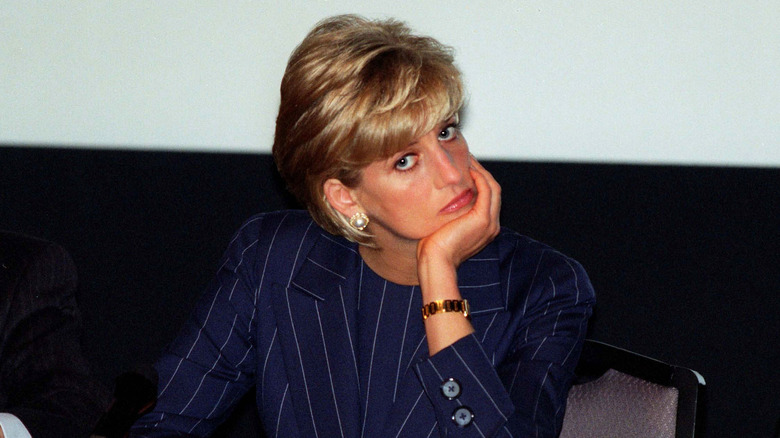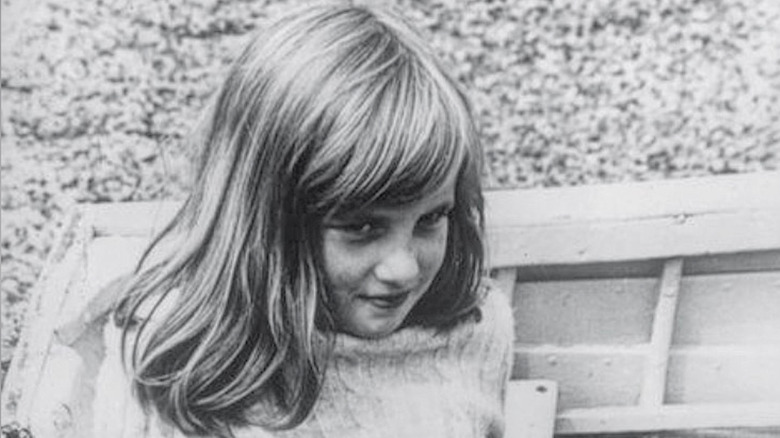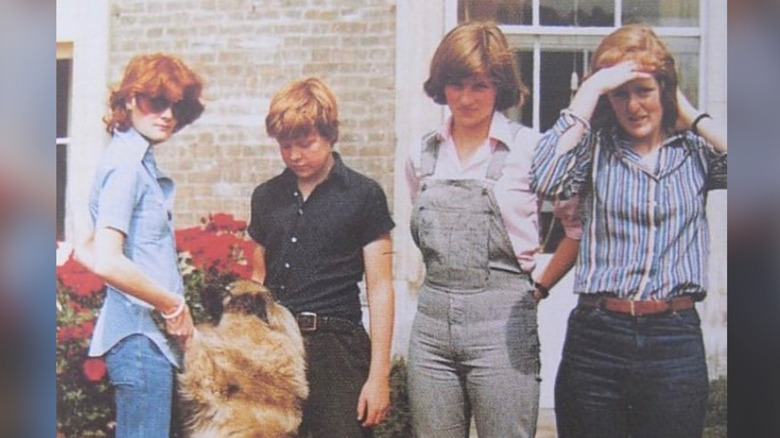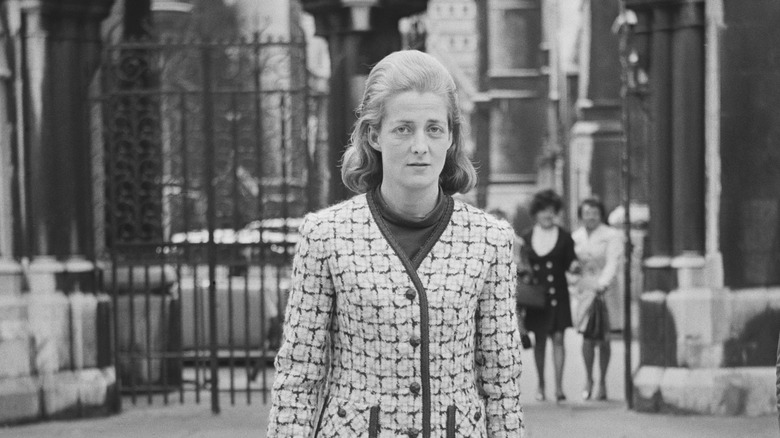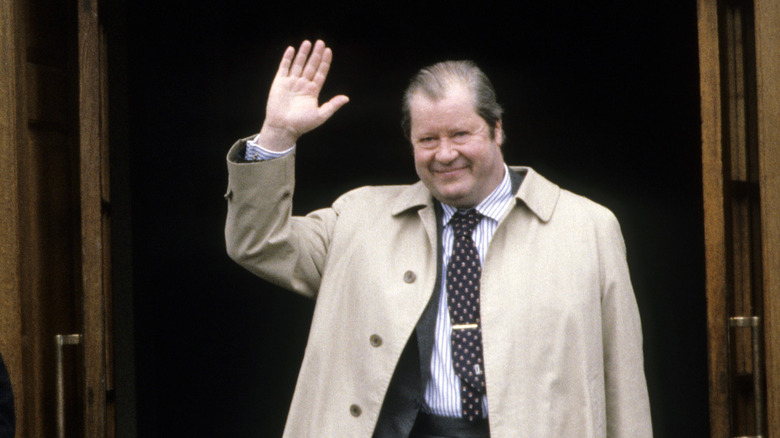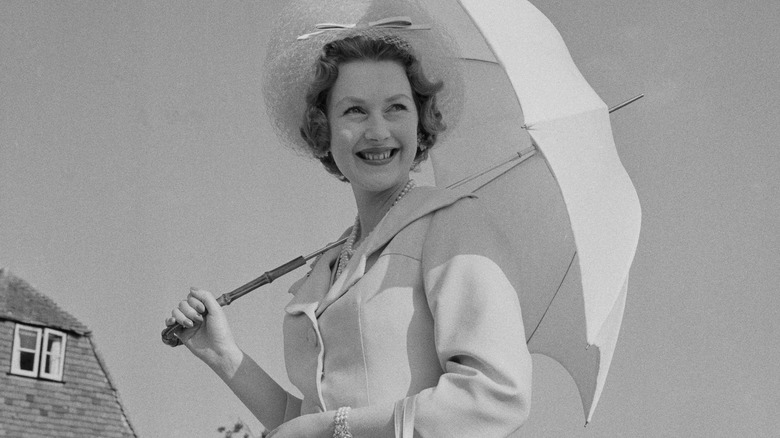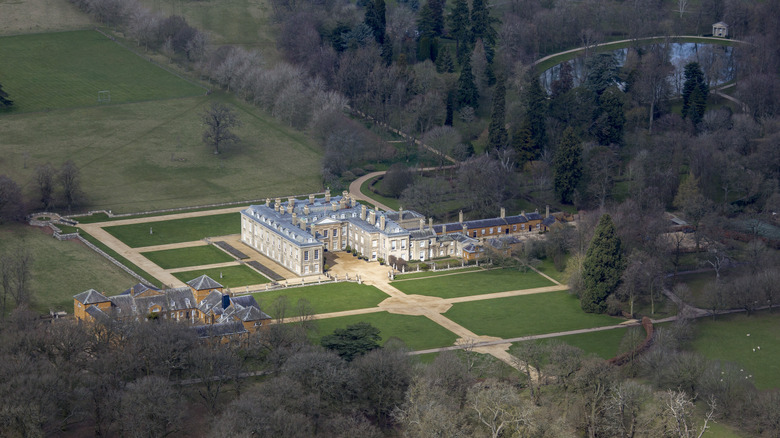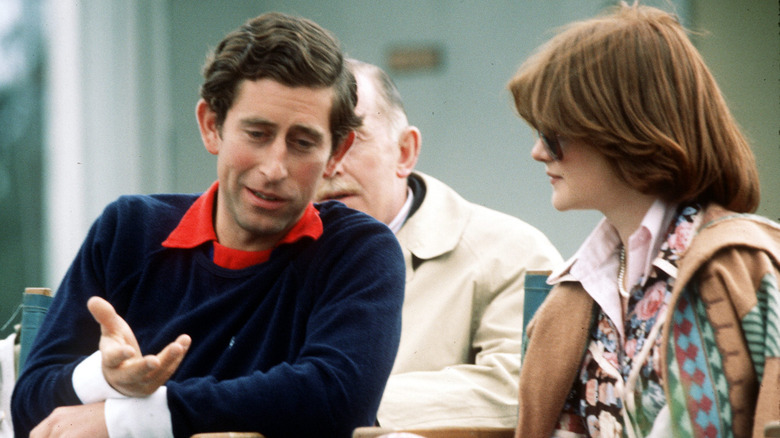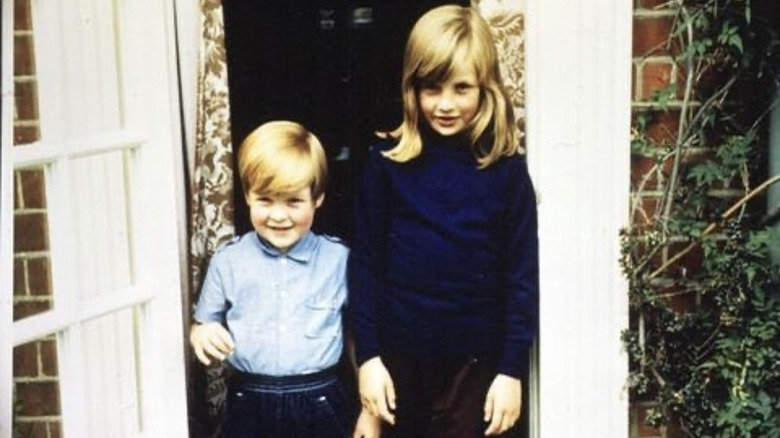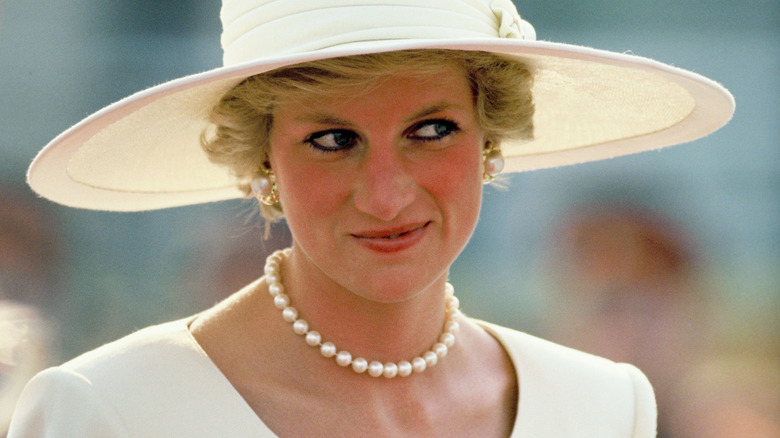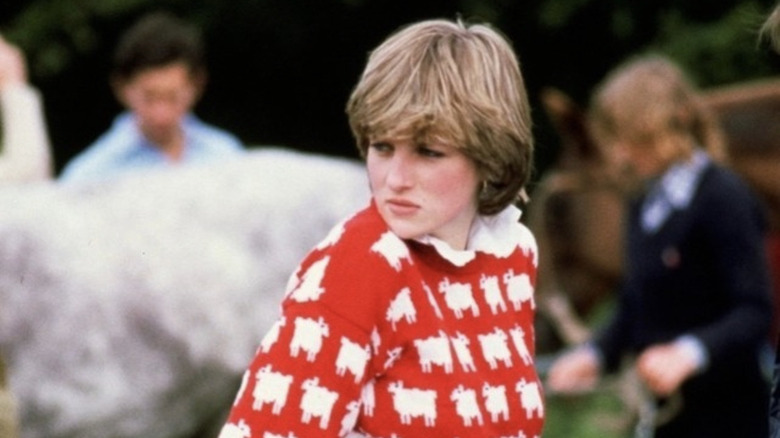A Look At Princess Diana's Dramatic Childhood
Before she married the Prince of Wales and captured the collective attention of the world, Princess Diana's childhood was a privileged beginning. Diana, Princess of Wales, born Diana Frances Spencer, hailed from a wealthy family with an aristocratic lineage that has been traced back to the Stuart kings. Diana's family lived on the royal estate at Park House in Sandringham until 1975, and her family maintained friendships with King George VI, the Queen Mother, and Queen Elizabeth II.
When Princess Diana was born in 1961, her father, John Spencer, was known as Viscount Althorp. When her grandfather died in 1975, her father became the 8th Earl Spencer and Diana gained the title of lady. Princess Diana's mother, Frances Shand Kydd, was the daughter of the 4th Baron Fermoy. Queen Elizabeth II was Diana's brother's godmother and young Diana played with Prince Andrew and Prince Edward as a child.
Despite the elevated status and friends in the highest places, the princess-to-be was not immune to family drama. Her parents' emotional divorce put Diana and her younger brother Charles in a position to navigate a life of drastic changes. She and her brother were fraught with insecurities that shaped their childhoods, and the siblings would go on to speak publicly as adults about the tumultuous time period. Understanding what Princess Diana endured as a child portrays her in a different light. Take a deeper look at Princess Diana's relationships with her family and the drama that transpired during her childhood.
Her parents' marital problems shaped her childhood
By the age of 5, Princess Diana's home had become a battleground for her parents' marriage. Her mother left the family home in 1967 and separated from Diana's father. Her parents eventually divorced in 1969 after a custody battle. "It was a very unhappy childhood. Always seeing our mum crying," Diana admitted in recordings published by the Daily Mail. "Daddy never spoke to us about it — we could never ask questions. Very unstable, the whole thing."
There were rumors of an affair and physical abuse, but Diana's brother, Charles, presented another theory of marital demise to the Sunday Times. Following the death of a newborn boy, John, in 1960 and the birth of a third healthy girl, Diana, in 1961, their father put an enormous amount of pressure on Frances to produce a male heir. The family convinced Frances to undergo gynecological testing to determine why she could not produce a male and Charles believes that Frances and John never got over this traumatic period.
Diana recollected traumatic interactions from her childhood. "I remember seeing my father slap my mother across the face," she confessed. "I was hiding behind the door, and Mummy was crying. I remember Mummy crying an awful lot." Once Frances left, Diana's brother recalled an image of a devastated young girl who would wait by the door for her mother to come home to no avail.
Princess Diana's father won the custody battle for the children
During the divorce trial, Diana's parents fought over custody of the children. Although Diana's older sisters were away most of the time at boarding school, the implications of the custody battle had a direct impact on the lives of Diana and her brother, Charles. According to The Guardian, Frances was described as a marriage breaker and adulteress during the trial. Diana's maternal grandmother, Ruth Roche, testified against her own daughter and Diana's mother lost custody of all four children to Diana's father.
Diana recalled that her emotional mother made the trips to see her very hard on Diana and Charles once her time with them was reduced to weekend custody. "Every Saturday, when we went up (to stay with her and Peter Shand Kydd) for weekends, every Saturday night, standard procedure, she would start crying," Diana said in a Daily Mail-published recording. "We would both see her crying. 'What's the matter, Mummy?' 'Oh, I don't want you to leave tomorrow,' — which, for a 9-year-old, was devastating, you know."
Once John took custody of the children, their upbringing was described as "disorganized" by The Independent and Diana assumed a mothering role with her younger brother. The children eventually welcomed the new spouses of their mother and father and, later, a new home and lifestyle when their father took the title of earl.
Diana lacked a stable maternal relationship throughout her childhood
Princess Diana had an incredibly strained relationship with her mother for as long as she could remember. Her brother, Charles, told the Sunday Times that Frances was "not cut out for maternity." He insisted, "Not her fault, she couldn't do it." Charles maintained that his mother was in love with someone else and self-absorbed in her own life's journey. She simply didn't leave room for the maternal guidance that could have helped the children cope.
Throughout her childhood, Diana didn't have a reliable maternal relationship. It has been reported that despite the fact that her maternal grandmother sided with Diana's father John in the custody battle, Princess Diana and her grandmother Ruth did not have a good relationship. Her grandmother did not favor Diana's eventual marriage to the Prince of Wales because she didn't believe Diana measured up to the future king.
Even as an adult, Diana could not rely on her mother. It was reported that Frances was a diva during the time of Diana's wedding, crying all the time and insisting the pressure was too much. Diana had no one maternal to lean on at that time because her mother was a mess. After the wedding, Diana didn't speak to Frances for many years. Although they eventually regained contact, Diana spent most of her adult life going no contact with her mother.
Princess Diana's relationship with her father
Princess Diana's father, the Viscount Althorp and 8th Earl Spencer, was raised in aristocracy, resided on royal grounds, and was prepared for his daughter to join the royal family. Princess Diana's adult relationship with her father seemed to be a good and loving relationship and John would eventually claim that walking the princess down the aisle for her marriage to the Prince of Wales was one of the proudest moments of his life. But Princess Diana recollected feelings of resentment from her father when she was a child. She felt the resentment stemmed from her simply being born another healthy girl to the Spencer family.
"I couldn't understand why I was perhaps a nuisance to have around, which in later years I've perceived as being part of the whole question of the child who died before me," she explained in a recording. "It was a son (John, who died within 10 hours of his birth in 1960) and both my parents were crazy to have a son and heir. 'What a bore, we're going to have to try again.' And then comes a third daughter." Despite the childhood recollections of resentment and disappointment, it has been widely reported that Diana and John had a close relationship until his death in 1992.
Diana had a contentious relationship with her stepmother
Another adjustment that Princess Diana had to make as a child was allowing room for her father's remarriage to Raine Legge. Royal Central reports that Diana was not a fan of her stepmother, Countess Spencer. Described as a "wicked stepmother" by the press, the politician, socialite, and party host "was a formidable woman who was both loved and loathed by high society."
John Spencer married Raine in 1976, the same year she divorced from her first husband, the 9th Earl of Dartmouth. It was known that the Spencer children referred to their stepmother as "Acid Raine" and would taunt her. For example, it was reported that the siblings "sang 'rain, rain go away' but never finished the well-known rhyme 'and come back another day'."
Two years into the marriage of John and Raine, Diana's father suffered a severe stroke that kept him hospitalized for months. During this time, Raine became very territorial about his recovery and didn't allow the Spencer children to visit him, which only worsened the relationship between Diana and her stepmother. Their relationship remained strained throughout adulthood for Diana and even reached a tipping point in 1989 when Diana pushed her stepmother down during a public argument at a party. Diana and Raine eventually reconciled their relationship in the last couple of years before her death.
Becoming a lady and moving to a new estate
When Diana was 14, her grandfather died, which caused her father to succeed to the title of 8th Earl Spencer. The earl inherited the family's mansion, Althorp House, which has been in the family since 1508 and serves as a home to royalty and aristocracy. According to the Evening Standard, the house spans 500 acres and has 90 rooms. Althorp Park, the estate, sits upon a sprawling 13,000 acres. The new home and the new way of life were a stark contrast for Diana and her brother, Charles.
It was also at this time that Diana became a lady due to her father's earldom. She was often referred to in the press by the nickname "Lady Di." Even after she married the Prince of Wales and became Diana, Princess of Wales, the public and press still used the beloved moniker, Lady Di.
The move from Sandringham to Northampton was over an hour away. Although it was an adjustment, Diana still found enjoyment. She would tap dance on the checkered floors of the great entrance, Wootton Hall, and it was said she loved the house and grounds. A former Althorp House cook told BBC, "Looking back, it was probably the happiest time of her life."
Princess Diana's relationship with her sisters grew stronger during adulthood
Diana also had two older sisters, Lady Sarah McCorquodale and Lady Jane Fellowes, who later became Baroness Fellowes. Lady Sarah is the eldest sister and was six years older than Diana. Lady Jane was four years older than Diana. Because of the age difference and the customary practice of boarding school for the aristocracy, Diana's older sisters were away at school for most of Diana's childhood. In a recording, Diana recalled, "Their growing up was done out of our sight. We saw them at holidays. I don't remember it being a big thing."
Just as Princess Diana was missing a strong maternal figure as a child, she also didn't get to develop a close bond with her sisters to help her cope with the drama of her childhood. According to Town & Country, the sisters teased Diana, as siblings often do, and Diana was said to have worshiped her sister Sarah from afar. As the sisters grew older, they grew closer and developed stronger relationships.
It was Lady Sarah who introduced Diana to her future husband, Prince Charles. In 1977, Sarah dated Prince Charles first but insisted she wasn't in love with Charles and that he wasn't ready to be married when she was dating him. There were no hard feelings between the sisters when she introduced Diana to the Prince of Wales and they began dating.
Princess Diana's relationship with her brother
Diana and her brother, Charles, were truly the foundation of each other's lives through the drama of their upbringing. The older sister served as a surrogate caregiver to her brother, who has admitted to feeling traumatized by his childhood. He had to change homes at age 2 and was sent to boarding school at age 8. He said of Diana, "She could hear me crying down the corridor but was too scared of the dark to come to me," when they were growing up.
Princess Diana explained in a recording, "I always looked after my brother, really." She joked, "We had so many changes of nannies, because Daddy was a very attractive divorcee and he was good bait for somebody. We tend to think they came for that, rather than for looking after my brother and me."
At Diana's funeral, her brother gave a memorable eulogy and credited his sister for becoming a surrogate mother to him. Charles stated that Diana "was the big sister who mothered me as a baby ... and endured those long train journeys between our parents' homes with me at weekends." Princess Diana is buried on the grounds of Althorp Park, where her brother currently resides as the 9th Earl Spencer.
The princess developed coping mechanisms to deal with the stress
Although Diana didn't always have strong female figures around to help her cope, she participated in many activities as a child that would later become her daily coping mechanisms to help her endure the endless drama that she experienced in adulthood. As a child she loved swimming, tennis, dance, and piano. Lady Di was known as a "swimming and diving star" at school and her instructor said of the future princess, "Diana swims and dives with speed and style."
From this childhood passion, Diana became a daily swimmer to help alleviate stress. She would swim up to 30 lengths of breaststroke and backstroke at the Buckingham Palace pool every morning around 7 a.m. She maintained her daily schedule even into adulthood while she was traveling as a member of the royal family.
Lady Diana also loved to dance and it was her first passion as a child. She had aspirations of becoming a professional dancer, but she was too tall. She relied on dancing to get her through some of her most harrowing times as a child, and she continued to use her passion to relieve her stress well into adulthood as a young royal. Her former teacher, Anne Allan said, "She has dance in her soul. I realize the pure enjoyment it gave her." She continued, "I could see that it helped alleviate her emotional life." (via YouTube).
How the princess made ends meet
Similar to other children of aristocrats, Lady Di attended boarding schools away from home. She was not a good student, and she struggled through her school experience as a teen. She failed her O-level exam twice, which is the standard exam that tests students to pass their secondary school education. At that point, she dropped out of West Heath, a girls' boarding school in Kent, and attended a finishing school in Switzerland for a brief time.
When she came back to London, she settled with flatmates and started working various jobs to make ends meet. She became known as a Sloane Ranger – a fashionable, upper-class woman who lived and socialized around West London. Luxury London described why Diana made the perfect leader of the Sloane Rangers — In their estimation, Diana was "stylish without being radically so; attractive without being (whatever some reckon) traffic-stoppingly beautiful; not exactly a big brain, as befitted a very old-school, upscale way of thinking that contrasted femininity and intellectualism."
She earned just five pounds an hour as a babysitter, and also worked as a cleaning lady and a cocktail server. Her family gave her an inheritance and she didn't have financial worries, but she worked to fit in. Around the time she began dating Prince Charles, she was working as an assistant kindergarten teacher. In 1981, when Diana was 20, she and Prince Charles announced their engagement and Diana relocated to Clarence House to prepare for her life as a royal.
